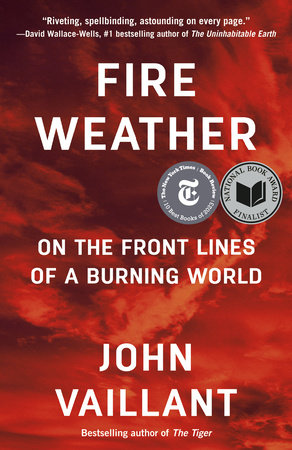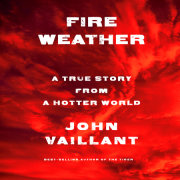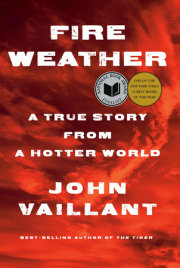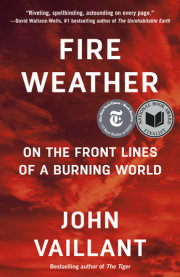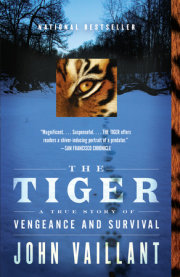PART one
ORIGIN STORIES
The National Weather Service issues a “Fire Weather Watch” when weather and fuel conditions may lead to rapid or dramatic increases in wildfire activity.
In this great chain of causes and effects, no single fact can be considered in isolation.
—Alexander von Humboldt
PROLOGUE
On a hot afternoon in May 2016, five miles outside the young petro-city of Fort McMurray, Alberta, a small wildfire flickered and ventilated, rapidly expanding its territory through a mixed forest that hadn’t seen fire in decades. This fire, farther off than the others, had started out doing what most human-caused wildfires do in their first hours of life: working its way tentatively from the point of ignition through grass, forest duff, and dead leaves—a fire’s equivalent to baby food. These fuels, in combination with the weather, would determine what kind of fire this one was going to be: a creeping, ground-level smolder doomed to smother in the heavy dew of a cool and windless spring night, or something bigger, more durable, and dynamic—a fire that could turn night into day and day into night, that could, unchecked and all-consuming, bend the world to its will.
It was early in the season for wildfires, but crews from the Wildfire Division of Alberta’s Ministry of Forestry and Agriculture were on alert. As soon as smoke was spotted, wildland firefighters were dispatched, supported by a helicopter and water bombers. First responders were shocked by what they saw: by the time a helicopter with a water bucket got over it, the smoke was already black and seething, a sign of unusual intensity. Despite the firefighters’ timely intervention, the fire grew from 4 acres to 150 in two hours. Wildfires usually settle down overnight, as the air cools and the dew falls, but by noon the following day this one had expanded to nearly 2,000 acres. Its rapid growth coincided with a rash of broken temperature records across the North American subarctic that peaked at 90°F on May 3 in a place where temperatures are typically in the 60s. On that day, Tuesday, a smoke- and wind-suppressing inversion lifted, winds whipped up to twenty knots, and a monster leaped across the Athabasca River.
Within hours, Fort McMurray was overtaken by a regional apocalypse that drove serial firestorms through the city from end to end—for days. Entire neighborhoods burned to their foundations beneath a towering pyrocumulus cloud typically found over erupting volcanoes. So huge and energetic was this fire-driven weather system that it generated hurricane-force winds and lightning that ignited still more fires many miles away. Nearly 100,000 people were forced to flee in what remains the largest, most rapid single-day evacuation in the history of modern fire. All afternoon, cell phones and dashcams captured citizens cursing, praying, and weeping as they tried to escape a suddenly annihilating world where fists of heat pounded on the windows, the sky rained fire, and the air came alive in roaring flame. Choices that day were stark and few: there was Now, and there was Never.
A week later, the fire’s toll conjured images of a nuclear blast: there was not just “damage,” there was total obliteration. Trying to articulate what she saw during a tour of the fire’s aftermath, one official said, “You go to a place where there was a house and what do you see on the ground? Nails. Piles and piles of nails.” More than 2,500 homes and other structures were destroyed, and thousands more were damaged; 2,300 square miles of forest were burned. By the time the first photos were released, the fire had already belched 100 million tons of carbon dioxide into the atmosphere, much of it from burning cars and houses. The Fort McMurray Fire, destined to become the most expensive natural disaster in Canadian history, continued to burn, not for days, but for months. It would not be declared fully extinguished until August of the following year.
Wildfires live and die by the weather, but “the weather” doesn’t mean the same thing it did in 1990, or even a decade ago, and the reason the Fort McMurray Fire trended on newsfeeds around the world in May 2016 was not only because of its terrifying size and ferocity, but also because it was a direct hit—like Hurricane Katrina on New Orleans—on the epicenter of Canada’s multibillion-dollar petroleum industry. That industry and this fire represent supercharged expressions of two trends that have been marching in lockstep for the past century and a half. Together, they embody the spiraling synergy between the headlong rush to exploit hydrocarbons at all costs and the corresponding increase in heat-trapping greenhouse gases that is altering our atmosphere in real time. In the spring of 2016, halfway through the hottest year of the hottest decade in recorded history, a new kind of fire introduced itself to the world.
“No one’s ever seen anything like this,” Fort McMurray’s exhausted and grieving fire chief said on national TV. “The way this thing happened, the way it traveled, the way it behaved—this is rewriting the book.”
1
If a tree burns in the forest and nobody sees it . . .
In Canada, this is more than a philosophical question. Canada contains 10 percent of the world’s forests, vast tracts of which are uninhabited. But “vast” is an ineffective descriptor when it comes to Canada, its forests, or its fires. One way to grasp the magnitude of this country is to get in a car in Great Falls, Montana, and head up I-15 to Sweetgrass, on the Canadian border. Once you’ve crossed into Coutts, Alberta, reset your odometer and point your car north. Then, settle into your seat for a couple of days. With the Rocky Mountains on your immediate left, this route takes you up the western edge of the Prairies, through Lethbridge, Calgary, and Red Deer—wheat and cattle country. Once past the northern metropolis of Edmonton, you will find yourself increasingly alone on the road, surrounded by broad expanses of hardscrabble subarctic prairie—fields frozen solid or half drowned and barely fit for cattle feed.
On the main road, now no wider than a residential street, hamlets with one blinking light and a gas station slide by and not another for fifty miles. To the east and west, gravel range roads run out to the vanishing point, and man-made structures appear more and more as intermittent novelties. Here, a schoolhouse-sized Ukrainian church with its tin-sheathed onion dome stands alone against a windswept loneliness so profound it suggests the Russian steppe. There, a barn collapses asymmetrically beneath the weight of a hundred heavy years, fully half of them spent clenched in the fist of winter, the people long gone. Farther on, a ten-acre lake so startlingly blue that mere reflection, even of Alberta’s sky, seems insufficient to explain it. Somewhere along the way, you will cross an unmarked divide where deer give way to moose, crows give way to ravens, and coyotes give way to wolves. By the time you get to North Star, the wide-open spaces for which Alberta is famous will be filled in by low, mixed forest and bogland that bears a strong resemblance to Siberia. By the time you stop for coffee in a lonely place called Indian Cabins, it will be tomorrow and your odometer will be approaching one thousand miles, but you will still be in Alberta.
Up here, in the landlocked subarctic, things seem to occur in outsized dimensions: lakes can be the size of inland seas and the trout inhabiting them can weigh a hundred pounds; large wild animals, including the continent’s biggest bison, outnumber people. In Wood Buffalo National Park, the second-largest national park in the world, is the world’s largest known beaver dam. Spotted in 2007 with the aid of a satellite, it is more than twice as long as the Hoover Dam, and it appears to be growing. In 2010, an adventurous man from New Jersey named Rob Mark set out to visit it. He was allegedly the first person to do so, and it was hard going. “The foliage is so thick,” Mark told the CBC, “you can’t see very far . . . then it turns into muskeg, which is incredibly difficult to walk on. And then it goes out to complete bog swamp.” It explains why so few outsiders frequent this place in the warmer months, and why winter is the preferred season for cross-country travel. “The mosquitoes,” added Mark, “are absolutely horrific.”
One exception to the general gigantism can be found in the trees, which seldom exceed sixty feet in height or a hundred years in age. These woods, a shifting mix of pine, spruce, aspen, poplar, and birch, are known collectively as the boreal forest, and whatever they may lack in individual size, they compensate for in sheer numbers. Girdling the Northern Hemisphere in a circumpolar band, the boreal forest is the largest terrestrial ecosystem, comprising almost a third of the planet’s total forest area (more than 6 million square miles—larger than all fifty U.S. states). Fully a third of Canada is covered by boreal forest, including half of Alberta. Continuing west, over the Rocky Mountains, through British Columbia, the Yukon, Alaska, and across the Bering Strait into Russia (where it is known as the taiga), the boreal forest stretches all the way to Scandinavia and then, undeterred by the Atlantic Ocean, makes landfall on Iceland before picking up again in Newfoundland and continuing westward to complete the circle, a green wreath crowning the globe.
As densely wooded as the boreal might appear from the roadside, it is, within, something far more amphibious, containing more sources of fresh water than any other biome. In this sense, the circumboreal forest resembles a kind of hemispheric sponge that happens to be covered in trees, their billions of miles of roots weaving the continents together in a subterranean warp and weft. While not as openly fluid as Florida’s Everglades, the boreal’s countless lakes, ponds, bogs, rivers, and creeks serve a similar function of gathering, storing, filtering, and flushing fresh water. Billions of birds, representing hundreds of species, live in and migrate through this ecosystem.
One reason the trees never get very big or very old is because, in spite of all that water, they burn down on a regular basis. They’re designed to. In this way, the circumboreal is truly a phoenix among ecosystems: literally reborn in fire, it must incinerate in order to regenerate, and it does so, in its random patchwork fashion, every fifty to a hundred years. This colossal biome stores as much, if not more, carbon than all tropical forests combined and, when it burns, it goes off like a carbon bomb. In North America, the epicenter for these stratospheric explosions is northern Alberta. Because of this, every town up here, big or small, faces the same dilemma: where the houses end, the forest begins. There are bears, wolves, moose, and even bison in there, but the most dangerous thing hiding in those woods is fire. Under the right conditions, a big boreal fire can come on like the end of the world, roaring and unstoppable. These are fires that can burn thousands of square miles of forest along with everything in it and still be out of control.
Virtually unknown and, at the time, unseen by all but a handful of people, is the Chinchaga Fire of 1950, the largest fire ever recorded in North America. Igniting on the border of British Columbia and Alberta in June of that year, it burned eastward across northern Alberta for more than four months, impacting approximately 4 million acres, or 6,400 square miles, of forest (roughly, the combined area of Connecticut and Rhode Island, or three times the size of Prince Edward Island). The fire generated a smoke plume so large it came to be known as the Great Smoke Pall of 1950. Rising forty thousand feet into the stratosphere, the plume’s colossal umbra lowered average temperatures by several degrees, caused birds to roost at midday, and created weird visual effects as it circled the Northern Hemisphere, including widespread reports of lavender suns and blue moons. Prior to the Chinchaga Fire, the last time such effects had been reported on this scale was following the eruption of Krakatoa in 1883. Carl Sagan was sufficiently impressed by the effects of the Chinchaga Fire to wonder if they might resemble those of a nuclear winter.
Every year, the National Oceanic and Atmospheric Administration (NOAA), in cooperation with fire scientists from Canada and Mexico, issues a document called the North American Seasonal Fire Assessment and Outlook, which attempts to predict the likelihood of wildfires across the continent. The Outlook includes maps for each month of fire season, and they are color-coded, with red indicating a likelihood of increased fire activity and green indicating a decrease. Like 2015 before them, the monthly maps for 2016 showed a lot more red than green, and the map for May showed more red than all the others: in addition to large swaths of Mexico, the American Midwest, and all of Hawai’i, red covered much of southern Canada—from the Great Lakes all the way to the Rocky Mountains. It was an enormous area and included most of Alberta’s active petroleum fields. In the middle of that hot zone, in the middle of the forest, sat Fort McMurray.
Fort McMurray is an anomaly in North America. Located six hundred miles north of the U.S. border and six hundred miles south of the Arctic Circle, the city is an island of industry in an ocean of trees. Without the lure of petroleum, this part of Alberta would resemble Siberia in even more ways than it already does: sparsely populated; its rivers spun like compass needles toward the Arctic Ocean; its trees low, short-lived, and prone to fire. Here, half a dozen permanent settlements dot a region the size of Kentucky, and only one has a population over 800: in 2016, Fort McMurray and its satellite communities were home to an international population of nearly 90,000 people living in 25,000 houses and buildings ranging from trailer homes and condominiums to McMansions and high-rise concrete apartments. The city’s “urban service area”—the area covered by garbage collection and firefighting services—covers twenty-six square miles of convoluted terrain laced with creeks and ravines that are further fragmented by two major rivers and two tributaries. Together, they surround and entwine the city like the writhing arms of an octopus.
Scattered across the surrounding landscape in semipermanent “man camps” was an additional shadow population of roughly fifty thousand workers whose numbers ebb and flow with the price of crude oil, the pace of development, and routine maintenance cycles at the processing plants. As one longtime resident put it, “We’re just a colony of oil companies.” Canada is the world’s fourth-largest oil producer and the third-largest exporter. Nearly half of all American oil imports—around 4 million barrels per day, come from there—the equivalent of one ultra large crude carrier ship every twenty-four hours. Of this vast quantity, almost 90 percent originates in Fort McMurray.
Copyright © 2023 by John Vaillant. All rights reserved. No part of this excerpt may be reproduced or reprinted without permission in writing from the publisher.

